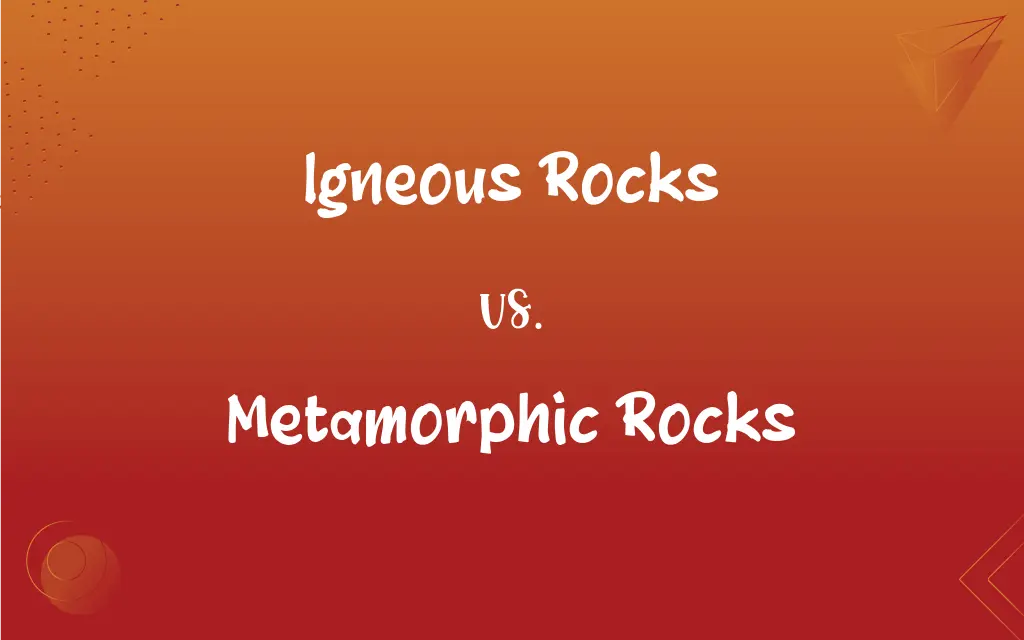Igneous Rocks vs. Metamorphic Rocks: What's the Difference?
Edited by Aimie Carlson || By Janet White || Published on February 7, 2024
Igneous rocks form from cooled magma or lava, while metamorphic rocks arise from existing rocks transformed by heat and pressure.

Key Differences
Igneous rocks are formed through the cooling and solidification of magma or lava, a process that creates a distinctive crystalline structure. Metamorphic rocks, on the other hand, are created when existing rocks are subjected to significant heat and pressure, leading to physical and chemical changes without melting.
The classification of igneous rocks is based largely on their mineral composition and the rate at which they cooled, resulting in either intrusive (slow cooling) or extrusive (rapid cooling) varieties. Metamorphic rocks are classified based on the texture and composition changes due to metamorphism, resulting in varied types like schist or gneiss.
Igneous rocks often display a granular texture and can be either coarse-grained, as seen in granite, or fine-grained, as in basalt. Metamorphic rocks, in contrast, are characterized by their foliated or non-foliated textures, with foliation resulting from the alignment of minerals under pressure.
In igneous rocks, the crystal size is typically indicative of the cooling history, with larger crystals suggesting slower cooling deep within the Earth. Metamorphic rocks often show signs of deformation and recrystallization, indicating the intense conditions they were exposed to.
Examples of igneous rocks include granite and basalt, commonly found in volcanic regions, while examples of metamorphic rocks include slate and marble, often used in construction and sculpture due to their strength and aesthetics.
ADVERTISEMENT
Comparison Chart
Formation
From cooled magma or lava
From transformation of existing rocks
Texture
Granular, coarse or fine-grained
Foliated or non-foliated
Cooling Rate
Intrusive (slow) or extrusive (fast)
N/A (not formed from cooling)
Common Examples
Granite, Basalt
Slate, Marble
Uses
Construction, decorative stone
Construction, sculpture
ADVERTISEMENT
Igneous Rocks and Metamorphic Rocks Definitions
Igneous Rocks
Igneous rocks often have a crystalline texture due to the cooling process.
The crystalline structure of igneous rocks is evident in granite's granular appearance.
Metamorphic Rocks
They exhibit foliated or non-foliated textures based on mineral alignment.
Slate, used for roofing tiles, is a foliated metamorphic rock.
Igneous Rocks
These rocks can vary widely in mineral composition and color.
Obsidian, a dark-colored igneous rock, is used for ornamental purposes.
Metamorphic Rocks
These rocks undergo physical and chemical changes without melting.
Quartzite, a metamorphic rock, is formed from the metamorphism of quartz sandstone.
Igneous Rocks
Igneous rocks form from the solidification of molten magma or lava.
Granite, an igneous rock, is commonly used for kitchen countertops.
Metamorphic Rocks
Metamorphic rocks are typically strong and durable, suitable for various construction uses.
Slate's durability makes it a popular choice for flooring and outdoor walkways.
Igneous Rocks
They are categorized into intrusive and extrusive types based on their cooling location.
Basalt is an extrusive igneous rock found in many volcanic regions.
Metamorphic Rocks
Metamorphic rocks are formed from existing rocks transformed by heat and pressure.
Marble, a metamorphic rock, is used extensively in sculpture and architecture.
Igneous Rocks
Igneous rocks are among the most abundant rock types on Earth's surface.
Igneous rocks like pumice are often found near volcanic areas.
Metamorphic Rocks
Metamorphic rocks can originate from igneous, sedimentary, or other metamorphic rocks.
Gneiss, formed from granite, is a common metamorphic rock.
FAQs
What is the texture of igneous rocks?
They often have a granular texture, either coarse or fine-grained.
What defines an igneous rock?
Igneous rocks form from cooled and solidified magma or lava.
How are metamorphic rocks created?
They form from existing rocks transformed under heat and pressure.
How do intrusive and extrusive igneous rocks differ?
Intrusive rocks cool slowly inside the Earth, while extrusive rocks cool rapidly on the surface.
Are igneous rocks common on Earth's surface?
Yes, they are among the most abundant rock types on Earth's surface.
What are examples of igneous rocks?
Examples include granite and basalt.
What are some uses of metamorphic rocks?
They are used in construction, sculpture, and decorative arts.
Is granite an igneous or metamorphic rock?
Granite is an igneous rock.
What causes the foliation in metamorphic rocks?
Foliation is caused by the alignment of minerals under pressure.
Can metamorphic rocks originate from igneous rocks?
Yes, metamorphic rocks can form from igneous, sedimentary, or other metamorphic rocks.
Do metamorphic rocks have a specific texture?
They exhibit foliated or non-foliated textures.
What is the importance of igneous rocks in geology?
They provide insights into Earth's geological processes and history.
Can igneous rocks be transformed into metamorphic rocks?
Yes, under sufficient heat and pressure.
Are igneous rocks used in building construction?
Yes, they are commonly used in construction and as decorative stones.
Is marble an igneous or metamorphic rock?
Marble is a metamorphic rock.
Can igneous rocks form underground?
Yes, intrusive igneous rocks form underground.
Are all metamorphic rocks hard and durable?
Most are hard and durable, but their properties can vary.
What factors influence the characteristics of metamorphic rocks?
The original rock type, temperature, pressure, and fluid activities influence their characteristics.
Do metamorphic rocks always have a layered appearance?
Not always; some have non-foliated textures.
How are metamorphic rocks identified?
Through their distinct textures, mineral composition, and formation history.
About Author
Written by
Janet WhiteJanet White has been an esteemed writer and blogger for Difference Wiki. Holding a Master's degree in Science and Medical Journalism from the prestigious Boston University, she has consistently demonstrated her expertise and passion for her field. When she's not immersed in her work, Janet relishes her time exercising, delving into a good book, and cherishing moments with friends and family.
Edited by
Aimie CarlsonAimie Carlson, holding a master's degree in English literature, is a fervent English language enthusiast. She lends her writing talents to Difference Wiki, a prominent website that specializes in comparisons, offering readers insightful analyses that both captivate and inform.































































